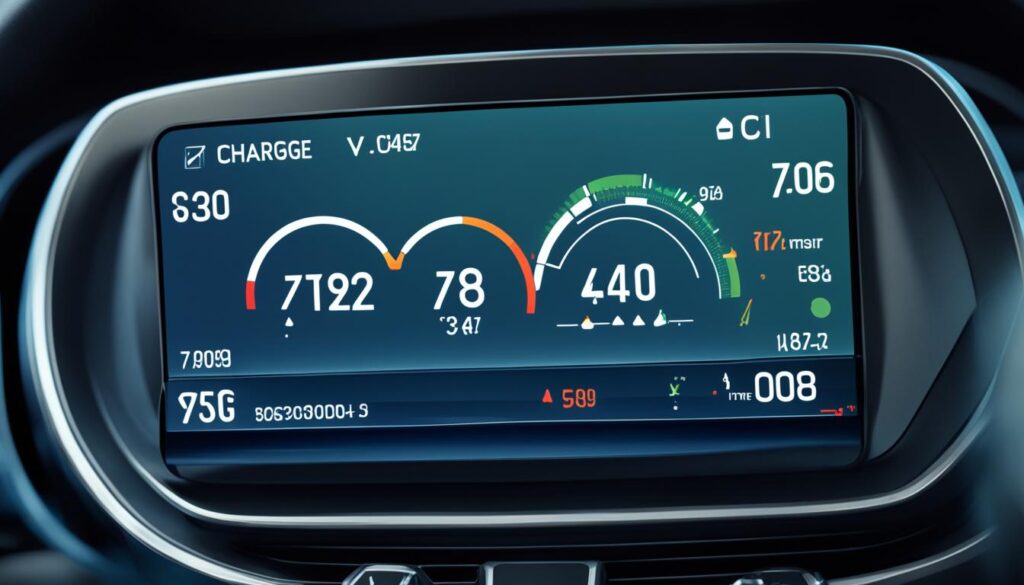The state of charge (SOC) is a crucial factor in electric vehicle (EV) driving. It refers to the amount of energy available in the battery at a specific time, expressed as a percentage. Understanding the full SOC and its implications is essential for maximizing driving range, efficiency, and overall battery performance.
When we talk about full SOC, we are referring to the battery being fully charged and ready for use. It is similar to having a full tank of fuel in a gasoline-powered car. Achieving a full SOC ensures that the battery has the maximum amount of energy available, allowing for longer trips and reducing range anxiety.
Monitoring the SOC is essential for electric vehicle owners, as it helps them keep track of the remaining range and plan charging accordingly. It also allows for identifying any anomalies or irregularities in battery performance, ensuring timely maintenance and troubleshooting.
There are various methods for determining the state of charge, such as the voltage method, specific gravity method, internal impedance method, and coulomb counting method. Each method has its advantages and limitations, and the choice depends on the battery type and application.
Extreme SOC levels, consistently operating at high or low levels, can accelerate battery degradation. To extend battery life, it is recommended to avoid extreme SOC levels and aim for reduced variations in SOC.
In conclusion, understanding the significance of full SOC when driving an electric vehicle is crucial for maximizing driving range, efficiency, and battery lifespan. By utilizing the various methods available to determine SOC and actively monitoring battery state, electric vehicle owners can make informed decisions about charging and optimize their driving experience.
Key Takeaways:
- Full SOC refers to the battery being fully charged and ready for use, similar to a full tank of fuel in a gasoline-powered car.
- Maintaining a full SOC ensures maximum driving range and efficiency in electric vehicles.
- Determining SOC can be done through methods such as voltage measurement, specific gravity measurement, internal impedance measurement, and coulomb counting.
- Extreme SOC levels can accelerate battery degradation, so it is important to avoid them and aim for reduced variations in SOC.
- Monitoring SOC in electric vehicles is crucial for battery maintenance, identifying anomalies in performance, and maximizing battery lifespan.
Importance of Full SOC for Electric Vehicles
Having a full state of charge (SOC) in an electric vehicle (EV) is critical for optimizing driving range and efficiency, and ensuring a smooth and confident driving experience. Let’s explore the key reasons why a full SOC is important for EV owners.
Maximizing SOC for Driving Range
When an EV’s battery is fully charged, it provides the maximum amount of energy available to power the vehicle. This translates into an extended driving range and the ability to travel longer distances before needing to recharge. By starting each journey with a full SOC, EV owners can confidently embark on trips without worrying about running out of battery power.
With a full SOC, EV drivers can unlock the full potential of their vehicle’s driving range, giving them the freedom to explore and travel with ease.
Enhancing Efficiency through Full SOC
Maximizing efficiency is another significant advantage of maintaining a full SOC in an EV. Electric vehicles are known to be most efficient when their batteries are charged to their maximum capacity. This means that by starting each drive with a full SOC, EV owners can optimize their energy utilization, reduce unnecessary charging cycles, and extend the overall efficiency of their vehicle.
Interpreting Full SOC in Car Driving
Interpreting a full SOC in an EV’s driving display is crucial for EV owners. It signifies that the battery is fully charged and ready for use. This visual confirmation reassures drivers that they have enough energy stored to complete their planned trips and eliminates any range anxiety they may have. Additionally, it enables EV owners to effectively plan their routes and charging stops based on the knowledge of having a full charge.
By maximizing SOC for driving range, optimizing efficiency, and interpretating full SOC in car driving displays, EV owners can fully leverage the benefits of their electric vehicles and enjoy a seamless and empowered driving experience. Understanding the significance of a full SOC is key to unlocking the potential of electric mobility.
Methods for Determining State of Charge
When it comes to determining the state of charge (SOC) of a battery, there are several methods that can be utilized. Each method offers its own unique approach to estimating SOC, providing valuable insights into the battery’s energy level. Let’s explore some of the most commonly used methods:
Voltage Method:
The voltage method involves measuring the battery’s voltage to estimate its SOC. A higher voltage typically indicates a fuller battery, while a lower voltage suggests a less charged battery. By analyzing the voltage readings, one can get a rough idea of the battery’s energy level.
Specific Gravity Method:
The specific gravity method, commonly used with lead-acid batteries, relies on a hydrometer to measure the density of the battery’s electrolyte. Changes in specific gravity correspond to changes in SOC. By monitoring specific gravity, one can gauge the battery’s charge status and make informed decisions regarding charging and usage.
Internal Impedance Method:
The internal impedance method measures the opposition presented by the battery to a current, providing insights into its SOC. By assessing the internal impedance, one can get an indication of how much energy the battery has stored. This method is particularly useful for batteries that exhibit specific impedance characteristics as they charge and discharge.
Coulomb Counting Method:
The coulomb counting method relies on measuring the current flowing in and out of the battery over time to estimate its SOC. By keeping track of the amount of charge that enters and leaves the battery, one can calculate the remaining SOC. This method is widely used in portable devices like laptops and smartphones, as it provides a precise estimate of the battery’s energy level.
Each method has its advantages and limitations, and the choice of method depends on the type of battery and the application in which it is being used. By leveraging these methods, manufacturers, engineers, and users can gain valuable insights into the state of charge of their batteries, enabling them to make informed decisions about usage, charging, and maintenance.

Now that we have explored the methods for determining the state of charge, let’s move on to examples of how these methods are applied in different industries and applications.
Examples of State of Charge Determining Methods
There are various methods for determining the state of charge (SOC) of a battery. Each method has its own advantages and limitations, and the choice of method depends on the type of battery and its intended application. Here are a few examples:
Voltage Method
The voltage method is a commonly used approach for determining SOC in certain applications. It involves measuring the battery’s voltage to estimate its state of charge. A higher voltage typically indicates a fuller battery, while a lower voltage suggests a less charged battery. This method is often utilized in golf cars, wheelchairs, and scooters due to its simplicity.
Coulomb Counting Method
The coulomb counting method is frequently used in portable devices like laptops and medical equipment. It involves measuring the current flowing in and out of the battery over time to estimate the state of charge. By keeping track of the electrical charge exchanged, this method provides a good estimate of the SOC.
Specific Gravity Method
The specific gravity method is primarily used with lead-acid batteries. It involves using a hydrometer to measure the density of the battery’s electrolyte. Changes in specific gravity correlate to changes in the state of charge. This method is particularly useful for monitoring and maintaining lead-acid batteries in various applications.
Each of these methods has its advantages and limitations. The voltage method is simple and widely applicable but may be less accurate in certain conditions. Coulomb counting provides precise measurements but can be affected by factors such as battery aging and self-discharge. The specific gravity method is useful for lead-acid batteries but may not be applicable to other battery chemistries.
Understanding the various state of charge determining methods allows for better management and utilization of battery systems across different applications.
State of Charge and Battery Aging
The state of charge (SOC) plays a crucial role in the aging of batteries. Consistently operating at extreme SOC levels, whether excessively high or low, can accelerate battery degradation and shorten its lifespan. To ensure optimal performance and extend the battery’s life, it is essential to avoid these extreme SOC levels and aim for reduced variations in SOC.
Avoiding the upper and lower limits of SOC helps mitigate the stress placed on the battery and minimizes the chemical reactions that contribute to its aging process. By maintaining the battery within a moderate range of SOC, you can significantly prolong its lifespan, ultimately maximizing its performance and longevity.
Keeping your battery within an optimal SOC range not only enhances its durability but also contributes to overall energy efficiency. When operating within the recommended SOC range, the battery can deliver power consistently and efficiently, ensuring a reliable and sustainable energy source for your device or vehicle.
Effects of SOC on Battery Aging
High SOC levels can cause several detrimental effects on battery aging, including accelerated capacity loss, increased internal resistance, and accelerated electrode degradation. Similarly, low SOC levels can also lead to irreversible battery damage, such as increased sulfation and reduced capacity.
| SOC Level | Impact on Battery Aging |
|---|---|
| High SOC |
|
| Low SOC |
|
Operating within an optimal SOC range helps alleviate these issues and ensures that the battery undergoes a more controlled aging process. By understanding and managing the SOC levels of your battery, you can effectively extend its lifespan and maintain optimal performance for longer periods.

Importance of State of Charge in Electric Vehicle Monitoring
Monitoring the state of charge (SOC) in electric vehicles is crucial for effective battery maintenance and optimal performance. By regularly monitoring the battery’s SOC, drivers can ensure they have sufficient energy for their journeys, plan their charging sessions effectively, and maximize the lifespan of their electric vehicle batteries.
One of the key advantages of monitoring SOC is the ability to keep track of the remaining range of an electric vehicle. Having knowledge of the battery’s SOC allows drivers to plan their trips accordingly, ensuring they don’t run out of charge in the middle of their journey. It also helps alleviate range anxiety, which is a common concern among electric vehicle owners.
Additionally, monitoring SOC plays a vital role in identifying any anomalies or irregularities in battery performance. By keeping a close eye on the SOC readings, drivers can detect potential issues such as abnormal battery drain or an inefficient charging process. Early identification of these problems enables timely maintenance and troubleshooting, preventing further damage to the battery.
Moreover, active monitoring of SOC is instrumental in optimizing electric vehicle battery lifespan. By maintaining the battery within the recommended SOC range, which is typically between 20% and 80%, the battery’s health can be preserved and its longevity extended. Keeping the SOC within this moderate range avoids extreme high or low levels that can accelerate battery degradation.
Incorporating state of charge monitoring into electric vehicle maintenance routines allows for a reliable and hassle-free driving experience. It ensures that the battery is always ready for use, and drivers can confidently embark on their journeys without worrying about unexpected power limitations.
| SOC Monitoring Benefits | Description |
|---|---|
| Optimized range planning | Drivers can estimate the remaining range and plan trips accordingly, reducing the risk of running out of charge. |
| Early anomaly detection | Monitoring SOC helps identify any irregularities in battery performance, enabling timely maintenance and troubleshooting. |
| Extended battery lifespan | By keeping the SOC within the recommended range, the battery’s health is preserved, maximizing its longevity. |
| Enhanced driving experience | Active SOC monitoring ensures a reliable and stress-free driving experience, with no unexpected power limitations. |
To visualize the benefits of SOC monitoring, refer to the table above.
Conclusion
In conclusion, understanding the importance of maintaining a full state of charge (SOC) when driving an electric vehicle is crucial for maximizing driving range, efficiency, and battery lifespan. Achieving and maintaining a full SOC ensures that the vehicle has the maximum amount of energy available, enabling longer trips and reducing range anxiety.
By utilizing the various methods available to determine SOC, such as the voltage method, coulomb counting method, and specific gravity method, electric vehicle owners can make informed decisions about charging and optimize their driving experience. Actively monitoring battery state and SOC allows for timely maintenance and troubleshooting, ensuring optimal battery performance and reliability.
In today’s world, where the shift towards electric vehicles is gaining momentum, understanding the significance of full SOC is paramount. It not only enhances the driving experience but also contributes towards sustainable transportation and reduced carbon emissions. By prioritizing a full SOC, electric vehicle owners can enjoy the benefits of maximum driving range, improved efficiency, and prolonged battery life, ultimately paving the way for a greener and cleaner future.










It is truly a nice and useful piece of info. I’m satisfied that you shared this useful information with us. Please keep us informed like this. Thank you for sharing.
Very efficiently written story. It will be beneficial to everyone who usess it, including myself. Keep doing what you are doing – for sure i will check out more posts.
Keep up the superb piece of work, I read few content on this site and I conceive that your website is very interesting and has lots of wonderful info .
Kelly Clarkson fakes Lori Loughlin nude Lori Loughlin nude Farrah Fawcett nude Cali Logan hot Lori Loughlin bikini Joanna Krupa hot Lori Loughlin fakes Lily Allen fakes Lori Loughlin topless Linsay Lohan nude Miranda Otto nude Miranda Otto nude priligy and viagra
I’ve been surfing online more than three hours these days, yet I never discovered any interesting article like yours. It is pretty value sufficient for me. In my view, if all web owners and bloggers made good content material as you probably did, the net will likely be much more useful than ever before. “I finally realized that being grateful to my body was key to giving more love to myself.” by Oprah Winfrey.
Very interesting topic, thank you for posting.
Hey There. I found your blog the use of msn. That is a really smartly written article. I’ll make sure to bookmark it and return to learn more of your helpful information. Thanks for the post. I’ll definitely comeback.
hello!,I like your writing very much! share we communicate more about your post on AOL? I need an expert on this area to solve my problem. May be that’s you! Looking forward to see you.